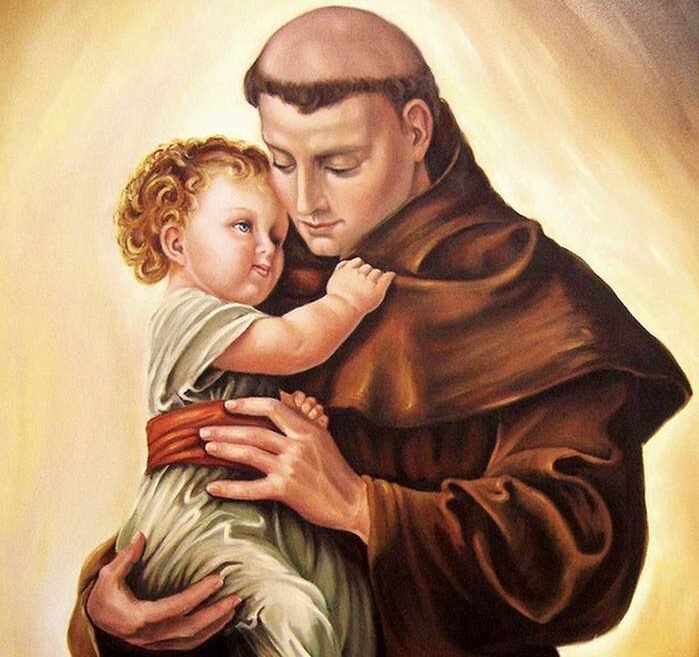Contenus
ToggleIn short
Antoine de Padoue (Antonio di Padova) ou Antoine de Lisbonne (15 août 1195 – 13 juin 1231) était un prêtre catholique portugais et frère de l’Ordre franciscain. Il est né et a grandi dans une famille aisée à Lisbonne, au Portugal, et est décédé à Padoue, en Italie. Remarqué par ses contemporains pour sa prédication puissante, sa connaissance experte des Écritures, son amour et sa dévotion éternels envers les pauvres et les malades, il fut l’un des saints les plus rapidement canonisés de l’histoire de l’Église. Il est proclamé docteur de l’Église par le pape Pie XII le 16 janvier 1946.

Antoine de Padoue et l'Ordre franciscain
Après son ordination sacerdotale, Fernando est nommé maître d’hôtel à l’âge de 19 ans et chargé de l’hospitalité de l’abbaye. Pendant qu’il était à Coimbra, des frères franciscains sont arrivés et se sont installés dans un petit ermitage à l’extérieur de Coimbra dédié à Antoine le Grand. Fernando était fortement attiré par le style de vie simple et évangélique des frères, dont l’ordre n’avait été fondé que 11 ans auparavant. La nouvelle est arrivée que cinq franciscains avaient été décapités au Maroc, les premiers de leur ordre à être tués.
Le roi Afonso II a racheté leurs corps pour qu’ils soient rendus et enterrés en tant que martyrs au monastère de Santa Cruz. Inspiré par leur exemple, Fernando obtint des autorités ecclésiastiques la permission de quitter les chanoines réguliers pour rejoindre le nouvel ordre franciscain. Dès son admission dans la vie des frères, il rejoint le petit ermitage des Olivais, prenant le nom d’Antoine (du nom de la chapelle qui s’y trouve, dédiée à Antoine le Grand), sous lequel il sera connu.
Antoine de Padoue partit alors pour le Maroc, en accomplissement de sa nouvelle vocation. Cependant, il tombe gravement malade au Maroc et repart pour le Portugal dans l’espoir de retrouver la santé. Lors du voyage de retour, le navire a été poussé hors de sa route et a atterri en Sicile.
De Sicile, il se rendit en Toscane, où il fut affecté à un couvent de l’ordre, mais il rencontra des difficultés en raison de son apparence maladive. Il a finalement été affecté à l’ermitage rural de San Paolo près de Forlì, en Romagne, un choix fait compte tenu de sa mauvaise santé. Là, il a eu recours à une cellule que l’un des frères avait faite dans une grotte voisine, passant du temps dans la prière et l’étude privées.
En 1222, dans la ville de Forlì, un certain nombre de frères dominicains en visite étaient présents à l’occasion d’une ordination, et un malentendu a surgi sur qui devrait prêcher. Les franciscains s’attendaient à ce que l’un des dominicains occupe la chaire, étant réputé pour sa prédication. Cependant, les dominicains étaient venus sans préparation, pensant qu’un franciscain serait l’homéliste. Dans ce dilemme, le chef de l’ermitage, qui ne pensait pas qu’aucun de ses humbles frères ne puisse donner une homélie pour l’occasion, fit appel à Antoine, qu’il soupçonnait d’être le plus qualifié, et le supplia de dire tout ce que l’Esprit Saint pourrait inspirer.
Antoine de Padoues’y est opposé, mais a été rejeté, et son sermon impromptu a créé une profonde impression sur son auditoire. Son auditoire a été ému non seulement par sa voix riche et ses manières saisissantes, mais aussi par le thème et la substance de son discours, sa profonde connaissance des Écritures et l’éloquence avec laquelle il a livré son message.
Antoine est ensuite envoyé par le frère Gratien, ministre provincial local, dans la province franciscaine de Romagne, basée à Bologne. Il attira bientôt l’attention du fondateur de l’ordre, François d’Assise. François avait eu une forte méfiance à l’égard de la place des études théologiques dans la vie de sa fraternité, craignant que cela ne conduise à un abandon de leur engagement dans une vie de vraie pauvreté et de service. En Antoine de Padoue, cependant, il a trouvé une âme sœur qui partageait sa vision et pouvait également fournir l’enseignement dont tout jeune membre de l’ordre souhaitant être ordonné pourrait avoir besoin. En 1224, il confie la poursuite des études de l’un de ses frères aux soins d’Antoine.
La pratique traditionnelle de prier pour l’aide de saint Antoine pour retrouver des objets perdus ou volés remonte à un incident survenu au cours de sa vie à Bologne. Selon l’histoire, Antoine de Padoueavait un book de psaumes qui était important pour lui, car il contenait ses notes et ses commentaires à utiliser pour enseigner à ses élèves. Un novice qui avait choisi de partir avait emporté le psautier avec lui. Avant l’invention de l’imprimerie, tout livre était copié à la main et, par conséquent, un article de grande valeur.
Un frère franciscain en particulier, compte tenu de son vœu de pauvreté, aurait trouvé un tel objet difficile à remplacer. Quand Antoine s’est rendu compte que son psautier avait disparu, il a prié pour qu’il soit retrouvé ou rendu, après quoi le voleur a été déplacé non seulement pour rendre le livre à Antoine, mais aussi pour revenir à l’ordre. Le livre volé serait conservé au couvent franciscain de Bologne.
À l’occasion, Antoine de Padoue occupait un autre poste d’enseignant dans des universités telles que l’Université de Montpellier et l’Université de Toulouse dans le sud de la France, mais sa prédication était considérée comme son don suprême. Selon l’historien Sophronius Clasen, Antoine a prêché « la grandeur du christianisme ». Sa méthode comprenait l’allégorie et l’explication symbolique des Écritures. En 1226, après avoir assisté au chapitre général de son ordre tenu à Arles, en France, et avoir prêché dans la région de Provence, Antoine retourna en Italie et fut nommé supérieur provincial du nord de l’Italie. Il a choisi la ville de Padoue comme emplacement.
En 1228, il est envoyé du chapitre général auprès du pape Grégoire IX. À la cour papale, sa prédication a été saluée comme un « écrin de la Bible » et il a été chargé de produire son recueil de sermons, Sermons for Feast Days (Sermones in Festivitates). Grégoire IX a décrit Antoine comme « l’Arche du Testament » (testament du docteur Arca).
L’histoire d’Antoine « prêchant aux poissons » est née à Rimini, où il était allé prêcher. Lorsque les hérétiques le traitèrent avec mépris, on dit qu’Antoine se rendit sur le rivage, où il commença à prêcher au bord de l’eau jusqu’à ce qu’une grande foule de poissons soit vue rassemblée devant lui. Les habitants de la ville ont afflué pour voir cette merveille, après quoi Antoine les a accusés du fait que les poissons étaient plus réceptifs à son message que les hérétiques de l’église, à quel point les gens ont été émus d’écouter son message.
Dans une autre histoire souvent racontée, qui a eu lieu à Toulouse, Antoine de Padoue a été mis au défi par un hérétique de prouver la réalité de la présence du Christ dans l’Eucharistie. L’homme, qui cherchait à se moquer d’Antoine, sortit une mule à moitié affamée et lui montra du fourrage frais d’une part, et l’hostie sacramentelle de l’autre. On dit que la mule a ignoré le fourrage et, au lieu de manger l’un ou l’autre, s’est inclinée devant le sacrement.
Un autre récit raconte une occasion en Italie où Antoine dînait avec des hérétiques. Il s’est rendu compte que la nourriture qu’ils lui présentaient était empoisonnée et il les a confrontés. Les hommes ont admis avoir tenté de le tuer, mais l’ont ensuite mis au défi de manger s’il croyait vraiment aux paroles prononcées dans Marc 16:18 à propos des apôtres du Christ : « … et s’ils boivent quelque chose de mortel, cela ne leur fera pas de mal. » On dit qu’Antoine a béni la nourriture, l’a mangée et n’a subi aucun mal, à la grande stupéfaction de ses hôtes.
Antoine est tombé malade d’ergotisme en 1231 et est allé à la retraite des bois à Camposampiero avec deux autres frères pour un répit. Là, il vivait dans une chambre construite pour lui sous les branches d’un noyer. Antoine mourut sur le chemin du retour à Padoue le 13 juin 1231 au monastère des Clarisses d’Arcella (qui fait maintenant partie de Padoue), à l’âge de 35 ans.
Conformément à sa demande, Antoine fut enterré dans la petite église de Santa Maria Mater Domini (datant probablement de la fin du XIIe siècle) et à proximité d’un couvent qu’il avait fondé en 1229. Néanmoins, en raison de sa notoriété accrue, la construction d’un La grande basilique a commencé vers 1232, bien qu’elle n’ait été achevée qu’en 1301. La plus petite église a été incorporée dans la structure sous le nom de Cappella della Madonna Mora (chapelle de la Vierge noire). La basilique est connue aujourd’hui sous le nom de « Il Santo » (Le Saint).
Diverses legends entourent également la mort d’Antoine. On soutient qu’à sa mort, les enfants ont pleuré dans les rues et toutes les cloches des églises ont sonné d’elles-mêmes. Une autre legend concerne sa langue. Il a été enterré dans une chapelle qui est devenue une partie de la basilique, où sa langue, sa mâchoire et ses cordes vocales ont été symboliquement choisies comme reliques de vénération (comme c’était la tradition à l’époque médiévale) pour être exposées dans un grand reliquaire.
Lorsque son corps a été exhumé 30 ans après sa mort, il a été retrouvé réduit en poussière, mais la langue aurait brillait et avait l’air de faire encore partie d’un corps vivant; une autre affirmation étant faite que c’était un signe de son don de prédication. Le 1er janvier 1981, le pape Jean-Paul II a autorisé une équipe scientifique à étudier les restes d’Antoine et la tombe a été ouverte cinq jours plus tard.
Social networks
Today, Christians celebrate Saint Anthony of Padua. It is notably the subject of chapters 39 and 40 of the legendary stories The Fioretti of Saint Francis of Assisi. Represented as a young, slender man holding the Child Jesus in his arms seated on a Bible, he is one of the most popular saints. #mythology #myth #legend #calendar #padua #antoniodipadova #lisbon #13June
Picture
